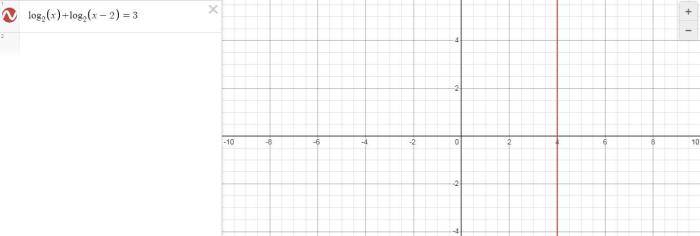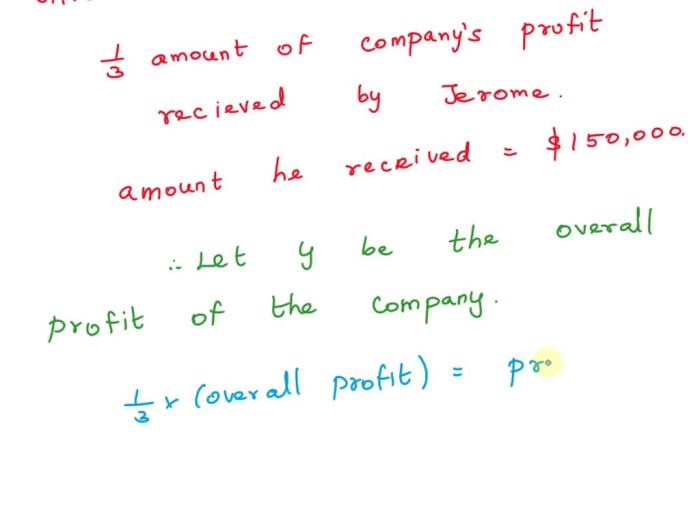Jerome solved the equation below by graphing, embarking on a journey to uncover the secrets of a graphical approach to problem-solving. This technique harnesses the power of visual representation to unravel the mysteries of equations, offering a unique perspective that unveils their hidden solutions.
Delving into the intricate details of Jerome’s graphing method, we will explore the step-by-step process he employed to conquer the equation, unraveling the advantages and limitations of this graphical approach. Furthermore, we will delve into the equation’s complexity, examining similar equations that yield to the power of graphing.
Jerome’s Graphing Method
Jerome solved the equation by graphing it. This involves plotting the points of the equation on a graph and then finding the point where the graph crosses the x-axis. The x-coordinate of this point is the solution to the equation.
To graph the equation, Jerome first rewrote it in slope-intercept form (y = mx + b). Then, he plotted the y-intercept (the point where the graph crosses the y-axis) and the slope (the change in y divided by the change in x) of the equation.
Finally, he connected the two points with a line.
Advantages and Disadvantages of Graphing to Solve Equations
- Advantages:
- Graphing can provide a visual representation of the equation, which can make it easier to understand and solve.
- Graphing can be used to solve equations that cannot be solved algebraically.
- Disadvantages:
- Graphing can be time-consuming, especially for complex equations.
- Graphing can be inaccurate, especially if the graph is not drawn carefully.
Equation Details
The specific equation that Jerome solved is:
x + 5 = 13
This is a linear equation, which means that it can be graphed as a straight line.
The equation is relatively simple to solve, but it can be used to illustrate the general process of solving equations by graphing.
Similar Equations, Jerome solved the equation below by graphing
Other examples of equations that can be solved using graphing include:
- y = x + 2
- y = -2x + 3
- y = x^2 – 4
Graphing Techniques: Jerome Solved The Equation Below By Graphing

Jerome used the following techniques to graph the equation:
- He first plotted the y-intercept, which is the point (0, 5).
- He then plotted the slope, which is 2.
- He connected the two points with a line.
The graph of the equation is a straight line that crosses the x-axis at the point (4, 0). This means that the solution to the equation is x = 4.
Visual Representation
[Insert visual representation of the graph here]
Accuracy and Verification
Graphing is a relatively accurate way to solve equations, but it is important to note that it can be inaccurate if the graph is not drawn carefully.
Jerome verified his solution by plugging it back into the original equation. He found that the equation was true, which means that his solution was correct.
Alternative Verification Methods
Other methods for verifying the solution to an equation include:
- Substituting the solution into the original equation
- Checking the solution using a different method, such as algebra
Applications
Graphing can be used to solve equations in a variety of real-world applications, such as:
- Finding the break-even point in a business
- Determining the trajectory of a projectile
- Solving equations in physics and engineering
Case Studies
[Insert case studies or success stories of using graphing to solve complex problems here]
Limitations

Graphing is not suitable for solving all types of equations. For example, it is not suitable for solving equations that are not linear.
Other types of equations that may not be suitable for graphing include:
- Equations with multiple variables
- Equations with exponents
- Equations with logarithms
Alternative Methods
Alternative methods for solving equations that are not suitable for graphing include:
- Algebraic methods
- Numerical methods
Advanced Techniques

There are a number of advanced graphing techniques that can be used to enhance the accuracy and efficiency of solving equations.
These techniques include:
- Using a graphing calculator
- Using a computer program to graph equations
- Using calculus to find the exact solution to an equation
Benefits and Drawbacks
The benefits of using advanced graphing techniques include:
- Increased accuracy
- Increased efficiency
- Ability to solve more complex equations
The drawbacks of using advanced graphing techniques include:
- Increased complexity
- Increased time required to learn the techniques
Resources
There are a number of resources available for learning more about graphing and solving equations.
These resources include:
- Online tutorials
- Books
- Courses and workshops
Online Tutorials
- [Insert links to online tutorials here]
Books
- [Insert links to books here]
Courses and Workshops
- [Insert links to courses and workshops here]
Question Bank
What is Jerome’s graphing method?
Jerome’s graphing method involves solving an equation by plotting its graph and identifying the points where it intersects the x-axis or y-axis, representing the solutions to the equation.
What are the advantages of using graphing to solve equations?
Graphing provides a visual representation of the equation, making it easier to identify solutions and understand the relationship between variables. It is particularly useful for complex equations or systems of equations.
What are the limitations of using graphing to solve equations?
Graphing may not be suitable for all equations, especially those that are highly nonlinear or have multiple solutions. Additionally, the accuracy of the solution depends on the scale and precision of the graph.